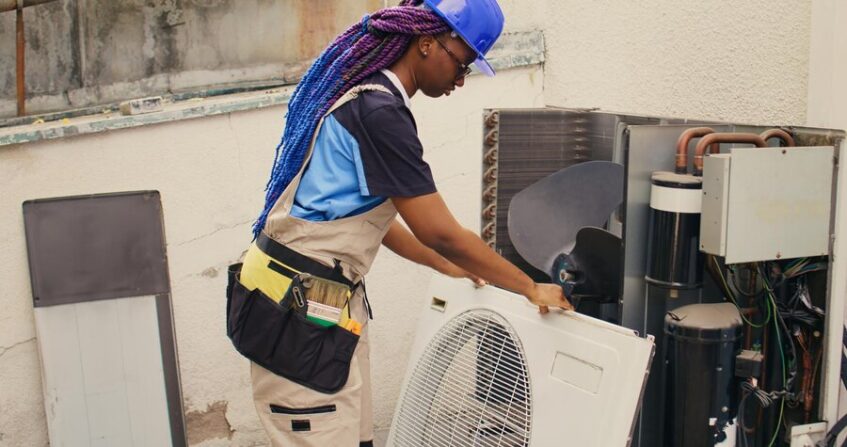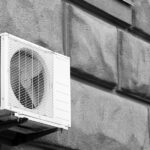
What Are Common Signs of AC Repair Needs?
Is your air conditioner not performing as it should? Understanding the common signs indicating AC repair needs can save you from sweltering in the heat or shivering during colder months. When your AC starts emitting strange noises, such as grinding or squealing, it’s often a sign of mechanical issues that require immediate attention. These sounds can indicate problems with the fan or motor, both critical components for efficient cooling. Additionally, if you notice inconsistent cooling throughout your home despite setting a consistent temperature, it could signify issues with the thermostat or ductwork, demanding professional inspection and repair services.
Regular maintenance and timely repairs are essential to keep your AC running smoothly and efficiently, ensuring comfort throughout the year. Don’t ignore these signs; instead, address them promptly to prevent more extensive and costly repairs down the road.
The Importance of AC Maintenance
Before delving into AC repair specifics, it’s crucial to highlight the importance of regular maintenance. Your air conditioner, much like your car, requires periodic tune-ups to perform optimally. Regular checks and maintenance not only ensure that your AC runs efficiently but also extend its lifespan. Routine inspections can catch minor issues—such as dirty filters or worn-out parts—before they escalate into major problems, potentially saving you from costly repairs or the need for premature replacement. By investing in regular maintenance, you not only maintain comfort in your home but also protect your financial investment in your AC unit over the long term.
Signs That Your AC Needs Repair
Recognizing when your AC needs repair can prevent discomfort and costly repairs down the line. Here are some common signs that indicate your AC requires attention:
- Poor Airflow: If you notice weak or inconsistent airflow from your vents, it could indicate issues with the compressor or ductwork.
- Strange Noises: Unusual sounds such as grinding, squealing, or banging often signal mechanical problems within the AC unit. Ignoring these noises can lead to further damage.
- Warm Air: When your AC blows warm air instead of cold, it may indicate refrigerant issues, compressor problems, or restricted airflow.
- Frequent Cycling: AC units typically cycle on and off to maintain a consistent temperature. However, frequent cycling can indicate issues with the thermostat, electrical components, or improper unit sizing.
- High Humidity Levels: Your AC not only cools but also dehumidifies the air. If you notice excessive humidity indoors despite the AC running, there may be a problem with the unit’s dehumidification capabilities.
Common AC Problems and Their Solutions
Refrigerant Leaks
Refrigerant is crucial for your AC to cool the air effectively. If you suspect a refrigerant leak (signaled by reduced cooling capacity), it’s essential to have a professional HVAC technician locate and repair the leak. Simply adding more refrigerant without fixing the leak is not a sustainable solution and can lead to further environmental harm.
Frozen Evaporator Coils
Frozen evaporator coils can result from restricted airflow or low refrigerant levels. This issue prevents your AC from cooling effectively and can eventually lead to compressor failure if not addressed promptly. It’s important to identify the root cause (such as dirty air filters or blocked vents) and then thaw the coils carefully to prevent damage.
Faulty Compressor
The compressor is the heart of your AC unit, responsible for circulating refrigerant and facilitating heat exchange. Compressor issues often manifest as loud noises, warm air blowing from vents, or frequent circuit breaker trips. Repairing or replacing a faulty compressor is a complex task best left to experienced HVAC professionals due to the intricacies involved.
Electrical Problems
Electrical issues can range from a malfunctioning thermostat to faulty wiring or capacitor problems. These can cause your AC to behave erratically, cycle frequently, or fail to turn on altogether. Given the electrical hazards involved, it’s crucial to hire a licensed technician for diagnosis and repairs.
Clogged or Dirty Air Filters
One of the simplest yet most common reasons for AC inefficiency is clogged or dirty air filters. Dirty filters restrict airflow, forcing your AC to work harder to cool your home. Regularly replacing or cleaning air filters (typically every 1-3 months, depending on usage and filter type) can significantly improve your AC’s efficiency and longevity.
Spotting Signs Your AC Needs Repair: A Quick Guide
Spotting signs that indicate your AC needs repair can prevent discomfort and costly repairs down the road. One common indicator is poor airflow, where you may notice weak or inconsistent airflow from your vents. This could be due to issues with the compressor or ductwork, hindering your AC’s ability to cool effectively. Additionally, strange noises such as grinding, squealing, or banging may signal mechanical problems within the unit. Ignoring these sounds can lead to more extensive damage over time, so it’s essential to address them promptly.
Another critical sign to watch for is warm air blowing from your AC instead of cool air. This could point to refrigerant issues, compressor problems, or restricted airflow, all of which require professional attention. By staying vigilant and recognizing these signs early on, you can ensure your AC operates efficiently and reliably throughout the seasons.
Keep Cool: Recognizing Common AC Repair Signals
To keep cool and comfortable at home, it’s crucial to recognize common AC repair signals before they escalate. If your AC frequently cycles on and off or struggles to maintain a consistent temperature, it could indicate thermostat issues or improper unit sizing. Similarly, high humidity levels indoors despite the AC running may signify a problem with the unit’s dehumidification capabilities, impacting both comfort and air quality.
Visible leaks or moisture around your AC unit should also prompt immediate action, as they can indicate refrigerant leaks or drainage issues. Addressing these leaks promptly can prevent further damage to your AC system and potential health hazards from mold or mildew growth. By staying proactive and identifying these common AC repair signals early, you can avoid unexpected breakdowns and maintain a cool, comfortable home environment.
Is Your AC on the Blink? Here’s What to Look For
When your AC is on the blink, identifying specific signs can help you determine if repair is necessary. If you notice unusual sounds like rattling or hissing, it may indicate loose components or debris inside the unit. These noises often worsen over time and can lead to significant mechanical failures if left unattended. Additionally, if your energy bills suddenly spike without a corresponding increase in usage, it could signal inefficiencies within your AC system, such as clogged filters or ductwork issues.
Pay attention to how your AC performs overall. If it struggles to cool your home adequately or if certain rooms remain warmer than others, there may be underlying issues affecting its performance. By addressing these signs promptly and consulting with a qualified HVAC technician, you can restore your AC’s efficiency and avoid more extensive repairs down the line.
AC Troubles? Recognize the Signs and Act Fast
When AC troubles arise, recognizing the signs and acting quickly can minimize discomfort and prevent further damage. One of the most noticeable signs is a sudden decrease in cooling capacity or airflow, indicating potential issues with the compressor, refrigerant levels, or airflow restrictions. Similarly, if your AC emits foul odors when running, it may suggest mold or mildew growth within the unit or ductwork, which requires immediate attention for both health and operational reasons.
Regular maintenance and prompt repairs are essential for prolonging the lifespan of your AC unit and ensuring consistent comfort in your home. By familiarizing yourself with these common AC repair signs and acting swiftly when they appear, you can maintain optimal performance and efficiency year-round.
Don’t Sweat It: Identifying AC Repair Needs Made Easy
Identifying AC repair needs doesn’t have to be stressful. By familiarizing yourself with the common signs of AC problems, you can act quickly to prevent discomfort and costly repairs. One telltale sign is inconsistent cooling throughout your home, where certain rooms may feel warmer than others. This could indicate issues with airflow distribution or thermostat calibration. Additionally, if your AC unit emits unpleasant odors when running, it may suggest mold or mildew growth inside the unit or ductwork, requiring immediate attention for both health and operational reasons.
Visual cues such as water leaks or moisture around your AC unit should also be addressed promptly, as they can indicate refrigerant leaks or drainage issues. These leaks not only compromise your AC’s performance but also pose potential health risks from mold growth. By taking proactive steps to identify and address AC repair needs, you can maintain a comfortable indoor environment and extend the lifespan of your AC system.
Recognizing the common signs that indicate your AC needs repair is essential for maintaining a comfortable home environment year-round. From inadequate cooling and strange noises to increased energy bills and visible leaks, these indicators shouldn’t be ignored. Addressing these issues promptly can prevent further damage, extend the lifespan of your AC unit, and save you from costly repairs down the line. Regular maintenance and timely repairs ensure that your AC operates efficiently, keeping you cool during the hottest days and maintaining indoor air quality.
If you’ve noticed any of these signs or suspect your AC needs repair, don’t hesitate to contact Cool Factory. Located at 45681 Oakbrook Ct, STE 101, Sterling, VA 20166, our experienced technicians are ready to diagnose and resolve your AC issues promptly. Call us today at (703) 713-5113 to schedule a consultation and keep your home comfortably cool all year long. For more information, visit our website at Cool Factory.






